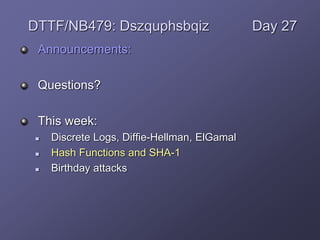
Hash Functions and SHA-1
- 1. Announcements: Questions? This week: Discrete Logs, Diffie-Hellman, ElGamal Hash Functions and SHA-1 Birthday attacks DTTF/NB479: Dszquphsbqiz Day 27
- 2. Hash Functions Goal: to provide a unique “fingerprint” of the message. How? Must demonstrate 3 properties: 1. Fast to compute y from m. 2. One-way: given y = h(m), can’t find any m’ satisfying h(m’) = y easily. 3. Strongly collision-free: Can’t find any m1 != m2 such that h(m1)=h(m2) easily 4. (Sometimes we can settle for weakly collision-free: given m, can’t find m’ != m with h(m) = h(m’). Message m (long) Message digest, y (Shorter fixed length) Cryptographic hash Function, h Shrinks data, so 2 messages can have the same digest: m1 != m2, but H(m1) = h(m2)
- 3. EHA: Easy Hash Algorithm Break m into n-bit blocks, append zeros to get a multiple of n. There are L of them, where L =|m|/n Fast! But not very secure. Doing a left shift on the rows helps a little: Define as left- shifting m by y bits Then ln 2 1 2 22 21 1 12 11 2 1 ... m m m m m m m m m m m m m l l n n l n c c c ... 2 1 y m y m m i i =h(m) 1 , 1 , 21 23 22 1 12 11 ... ... l l l l ll n m m m m m m m m m
- 4. EHA: Easy Hash Algorithm n c c c ... 2 1 =h(m) Exercise: 1. Show that the basic (unrotated) version doesn’t satisfy properties 2 and 3. 2. Show that the rotated version doesn’t satisfy properties 2 and 3 either. Conclusion: Need nonlinearity! 3 properties: 1. Fast to compute 2. One-way: given y = h(m), can’t find any m’ satisfying h(m’) = y easily. 3. Strongly collision- free: Can’t find m1 != m2 such that h(m1)=h(m2) ln 2 1 2 22 21 1 12 11 2 1 ... m m m m m m m m m m m m m l l n n l
- 5. SHA-1: Secure Hash Algorithm NSA NIST “This standard specifies a Secure Hash Algorithm (SHA), which is necessary to ensure the security of the Digital Signature Algorithm (DSA). When a message of any length < 264 bits is input, the SHA produces a 160- bit output called a message digest. The message digest is then input to the DSA, which computes the signature for the message. Signing the message digest rather than the message often improves the efficiency of the process, because the message digest is usually much smaller than the message. The same message digest should be obtained by the verifier of the signature when the received version of the message is used as input to SHA. The SHA is called secure because it is designed to be computationally infeasible to recover a message corresponding to the message digest. Any change to the message in transit will, with a very high probability, result in a different message digest, and the signature will fail to verify. The SHA is based on principles similar to those used by Professor Ronald L. Rivest of MIT when designing the MD4 message digest algorithm, and is closely modelled after that algorithm.” (Proposed Federal Information Processing Standard for Secure Hash Standard,” Federal Register, v. 57, n. 177, 11 Sep 1992, p. 41727) …how?
- 6. SHA-1: Prepare the message 1. Prepare the message. Given m, create mmm…m1000…000xxxxx….x: Append a 1 and then enough zeros to make the total congruent to 448 (mod 512) bits (to leave room for the length) Append the length of m (≤ 264, so can be written in 64 bits) Break into L 512-bit chunks. Each will be used to compress into a 160- bit total message digest. Example: Encode m with length 5000 bits. What is L? 1
- 7. SHA-1: Notation Bitwise AND Bitwise OR Bitwise XOR Bitwise NOT Left-shift, with wrap-around Addition, mod 232 2
- 8. SHA-1: Iterative compression Idea: iterate over all of the L blocks, outputting a value that is a function of the previous output and the current block: Now, the function h’… m1 m2 X0 X1 X2 h’ h’ m3 X3 h’ mL XL h’ =h(m) 3 (X0 is constant)
- 9. SHA-1: Compression function: h’ Input: X0 (160 bits), m1 (512 bits): Output: X1 (160 bits) 1 16 14 8 3 t t t t t W W W W W Expand m1 from 5122560 bits. m1=(W0..W15) (32 bits each) Initialization 4 rounds of 20 iterations each: Each round uses a different K and different nonlinear mixing function f W79 … W16 … W19 m1 W0 W1 W15 … a b c d e a b c d e H H H H H X 0 1 2 3 4 0 K0..19=0x5A827999 Round 1 K20..39=6ED9EBA1 K40..59=8F1BBCDC K60..79=CA62C1D6 Round 2 Round 3 Round 4 … (20 iters) 1 0 X X a b c d e 4-5
- 10. SHA-1: Iterative compression Repeat the algorithm on the previous slide L times until you’ve compressed the whole message into a single 160-bit vector. Each can be implemented in hardware. m1 m2 X0 X1 X2 h’ h’ m3 X3 h’ mL XL h’ =h(m) 6
- 11. Interesting trivia The NSA added the left shift in w after the fact. The change “corrects a technical flaw that made the standard less secure than have been thought”. (Proposed Revision of Federal Information Processing Standard (FIPS) 180, for Secure Hash Standard,” Federal Register, v. 59, n. 131, 11 Jul 1994, p. 35317-35318) 7-9
- 12. Summary What’s an attack on SHA-1 look like? In other words, how do we find collisions? Stay tuned… Next time we’ll learn what birthdays have to do with collisions How long before SHA-1 will be broken?